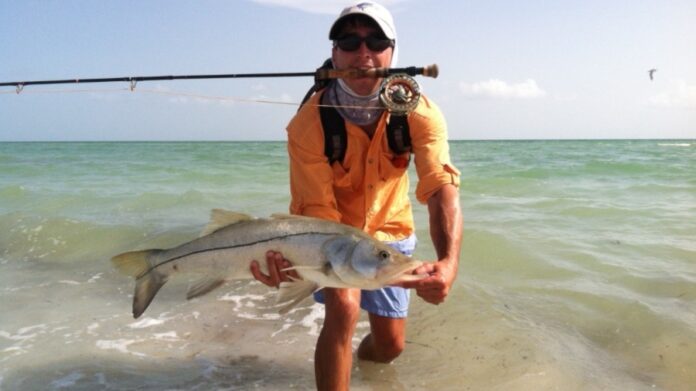Photo by Chris Hargiss
Florida may offer endless saltwater fly-fishing opportunities, but most of them require a boat and a guide, which can limit your options. One notable exception, however, is walking the beaches and fishing for snook, which is perfect for anglers looking for an easy DIY saltwater experience in the Sunshine State. The action is best from May through early September, when the water is warmest and the snook are actively cruising up and down the beaches between spawning sessions. You can catch snook on both coasts of Florida, but mostly south of Tampa/Melbourne. While the specifics of fly and gear selection can vary based on local conditions, the best strategies for approaching these fish are fairly universal, so if you get a chance to try beach snook fishing this summer, here are 5 tips to keep in mind:

Photo by Evan Jones
1. Keep the Sun at your Back
It may be tempting to start at the crack of dawn, but being able to see the snook as they swim along the shoreline is usually vital to your success, and you won’t be able to sightfish until the sun rises a bit higher in the sky. If you’re on the Gulf side (looking westward), the best time to go is mid-morning, but if you’re on the Atlantic side (looking eastward), you’ll want to wait until noon or later to ensure the sun isn’t shining directly into your face as you look for fish.
2. Pick a Nice, Calm Day
If your schedule is flexible, try to choose weekdays with the calmest winds and brightest sun to maximize your ability to sightfish. Bonus points if the high tide happens while you’re there, since the fish will cruise closer to shore when the water is high. If it’s cloudy and/or windy–especially if the wind is blowing on-shore–or if the water is still dirty from windy days earlier in the week, beach fishing can shut down to the point that it’s hardly worthwhile.

Photo by Evan Jones
3. Walk as Far as you Can
Most access points will be crowded with casual beachgoers, and while they don’t tend to stray too far from the parking lot, you should still come prepared for a long walk. Bring plenty of water, snacks, good sun protection, and sturdy footwear that won’t let sand in. (I’ve been getting good use out of the Pro Approach Hiker wading boots lately.) The more miles of beach you can cover in a day, the more likely you are to find some willing fish.
4. Vary your Retrieve
Snook are notorious for following flies without eating them, and frankly, that’s just part of the experience no matter what fly or technique you use. You can, however, boost your chances of convincing them to eat by varying the speed and length of your retrieve. I try to imitate the erratic movements of a dying baitfish that is struggling to stay upright by giving my fly a few short, quick bumps followed by a brief pause, and then a long, slow strip or two, followed by another pause. Mix it up until you find a cadence that starts to draw strikes.

Photo by Brent Wilson
5. Work your Fly All the Way In
Regardless of whether you can see snook following your fly or not, be sure to retrieve it all the way through the turbulent “wash” right at the shoreline. It may not look deep enough to hold fish, but snook like to take advantage of its disorienting effects on baitfish, and it’s not uncommon to hook a fish you never saw while your fly is tumbling through this final zone.
Evan Jones is the assistant editor of the Orvis Fly Fishing blog. He spent a decade living on the Florida coast and now lives in Colorado.
Credit: Source link































